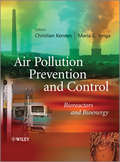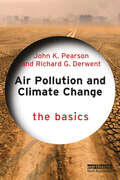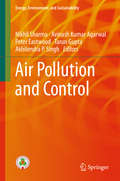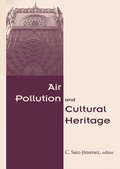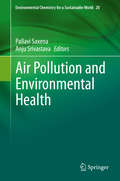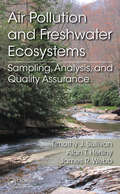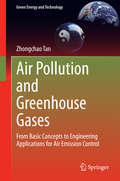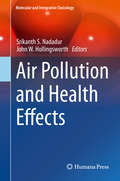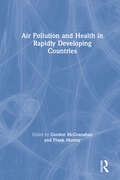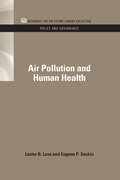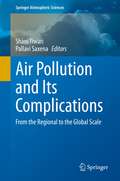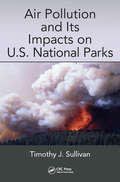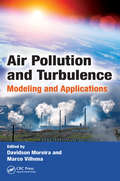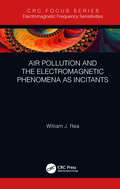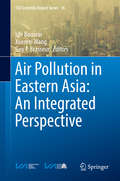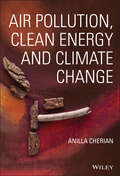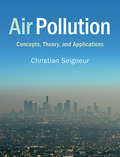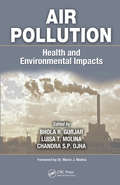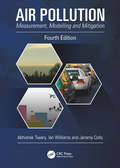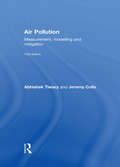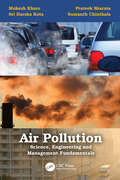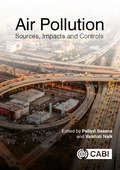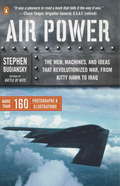- Table View
- List View
Air Pollution Prevention and Control
by Maria C. Veiga Christian KennesIn recent years, air pollution has become a major worldwide concern. Air pollutants can affect metabolic activity, impede healthy development, and exhibit carcinogenic and toxic properties in humans. Over the past two decades, the use of microbes to remove pollutants from contaminated air streams has become a widely accepted and efficient alternative to the classical physical and chemical treatment technologies. Air Pollution Prevention and Control: Bioreactors and Bioenergy focusses on these biotechnological alternatives looking at both the optimization of bioreactors and the development of cleaner biofuels.Structured in five parts, the book covers:Fundamentals and microbiological aspectsBiofilters, bioscrubbers and other end-of-pipe treatment technologiesSpecific applications of bioreactorsBiofuels production from pollutants and renewable resources (including biogas, biohydrogen, biodiesel and bioethanol) and its environmental impactsCase studies of applications including biotrickling filtration of waste gases, industrial bioscrubbers applied in different industries and biogas upgradingAir Pollution Prevention and Control: Bioreactors and Bioenergy is the first reference work to give a broad overview of bioprocesses for the mitigation of air pollution. Primarily intended for researchers and students in environmental engineering, biotechnology and applied microbiology, the book will also be of interest to industrial and governmental researchers.
Air Pollution and Climate Change: The Basics (The Basics)
by John K. Pearson Richard DerwentThis book identifies four key forms of air pollution: indoor, urban, regional and global. It discusses how these four types of pollution are manifest in today’s society and examines the scientific and policy challenges that stand in the way of progress. Written in a style that balances scientific underpinnings with accessible language, Pearson and Derwent examine the sources and historical context of air pollutants, before dedicating a chapter to each of the key forms. Armed with these basics, they begin to address the challenges faced by improving indoor, urban and regional air quality, whilst reducing global warming in the years ahead. This leads to a greater understanding of the challenges of global climate change, with new proposals for reducing global warming. However, the authors conclude that it is only when we have a scenario of reforestation combined with reductions in emissions of all greenhouse gases that real progress will be made in the fight against climate change. Then, air pollution will also be consigned to history. With a foreword written by Professor James Lovelock, this book will be of great interest to students and scholars of climate change and environmental policy, as well as air quality professionals working in this important field.
Air Pollution and Control (Energy, Environment, and Sustainability)
by Avinash Kumar Agarwal Tarun Gupta Akhilendra P Singh Nikhil Sharma Peter EastwoodThis book focuses on various aspects related to air pollution, including major sources of air pollution, measurement techniques, modeling studies and solution approaches to control. The book also presents case studies on measuring air pollution in major urban areas, such as Delhi, India. The book examines vehicles as a source of air pollution and addresses the quantitative analysis of engine exhaust emissions. Subsequent chapters discuss particulate matter from engines and coal-fired power plants as a major pollutant, as well as emission control techniques using various after treatment systems. The book's final chapter considers future perspectives and a way forward for sustainable development. It also discusses several emission control techniques that will gain relevance in the future, when stricter emission norms will be enforced for international combustion (IC) engines as well as power plants. Given its breadth of coverage, the book will benefit a wide variety of readers, including researchers, professionals, and policymakers.
Air Pollution and Cultural Heritage
by C. Saiz-JimenezThis collection includes thirty-six important recent works on the effects of pollutants on heritage sites, including thirty papers delivered to the Seville International Workshop on Air Pollution and Cultural Heritage in 2003, and six invited new additions. All papers have been written by a team of leading international contributors and are divided into five subject areas to cover the main topics of interest today. This volume is aimed at archaeologists and molecular biologists as well as advanced students and researchers in the fields of biodeterioration, building materials, micro-organisms and cultural heritage.
Air Pollution and Environmental Health (Environmental Chemistry for a Sustainable World #20)
by Pallavi Saxena Anju SrivastavaAir pollution is an alarming problem, not only in terms of air quality, but also in relation to health issues. Toxic air pollutant concentrations produce harmful impacts on plant health and human health. Further, though there are various sources of air pollution, anthropogenic and biogenic sources are becoming increasingly problematic. A number of control methods have been applied to reduce the air pollutant concentrations so that their global environmental burden on plants as well as humans can be mitigated. However, as confirmed in numerous reports and studies, their concentrations continue to be very high and everyday cases related to air pollution have become exponentially high not only in developing countries but also in developed countries. In plants, toxic air quality has various adverse effects, including biochemical and physiological disorders, chronic diseases and/or lower yields. In humans, air pollutants affect the body’s metabolism and immune system, lungs and central nervous system. This book provides an essential overview of air pollution, its impacts on plant and human health, and potential control strategies. The respective chapters cover general monitoring and characterization techniques for air pollutants, air quality modelling applications, plant and human health effects, risk assessment, and air pollution control policy. Given its scope, the book offers a valuable and unique resource for students of Environmental Science, Biological Science, Medical Science and Agriculture; and for environmental consultants, researchers and other professionals whose work involves air quality, plant and human related research.
Air Pollution and Freshwater Ecosystems: Sampling, Analysis, and Quality Assurance
by Timothy J Sullivan Alan T. Herlihy James R. WebbA practical book for professionals who rely on water quality data for decision making, this book is based on three decades experience of three highly published water and watershed resource professionals. It focuses on the analysis of air pollution sensitive waters and the consequent effects associated with soil and water acidification, nutrient-
Air Pollution and Greenhouse Gases: From Basic Concepts to Engineering Applications for Air Emission Control (Green Energy and Technology)
by Zhongchao TanThis textbook discusses engineering principles relating to air pollution and greenhouse gases (GHGs); it focuses on engineering principles and designs of related devices and equipment for air emission control for a variety of industries such as energy, chemical, and transportation industries. The book aims primarily at senior undergraduate and graduate students in mechanical, chemical and/or environmental engineering departments; it can also be used as a reference book by technical staff and design engineers who are interested in and need to have technical knowledge in air pollution and GHGs. The book is motivated by recent rapid advances in air pollution and greenhouse gas emissions and their control technologies. In addition to classic topics related to air pollution, this book is also featured with emerging topics related to air pollution and GHGs. It covers recent advances in engineering approaches to the reduction of GHG emissions including, but are not limited to, green energy technologies and carbon sequestration and storage. It also introduces an emerging topic in air pollution, which is referred to as Nano Air Pollution. It is a growing concern in air pollution, but largely missing in similar books, likely because of recent rapid advances in nanotechnology has outpaced the advances in nano air pollution control.
Air Pollution and Health Effects (Molecular and Integrative Toxicology)
by Srikanth S. Nadadur John W. HollingsworthExposure to ambient air pollutants, both indoors and outdoors has been associated with the exacerbation and also in the etiology of diverse human diseases. This book offers an overview of our current understanding of air pollution health risks and how this knowledge is being used in the regulatory, therapeutic intervention measures to protect the public health and reduce the disease burden caused by acute and long-term exposure to air pollutants. Air Pollution and Health Effects provides readers with a comprehensive understanding of air pollution health risks, morbidity and the global disease burden, whilst also delivering critical review on state of the art research so as to gain a fundamental understanding of the biological mechanisms involved in the etiology of air pollution-induced diseases. Chapters range from pregnancy outcomes and pre-term birth, carcinogens in the ambient aerosol and the health consequences of indoor biomass burning. Special emphasis is placed on regional and local air pollution and its impact on global health along with suitable preventive and interventional measures. With contributions from international experts in the field this volume is a valuable guide for researchers and clinicians in toxicology, medicine and public health as well as industry and government regulatory scientists involved in health protection.
Air Pollution and Health in Rapidly Developing Countries
by Gordon McGranahan Frank MurrayIn developing countries the price of rapid growth is all too often noxious airborne pollution, which annually contributes to a disturbing number of avoidable deaths. In recent decades, however, there has been considerable progress in the epidemiology of air pollution, significant changes in international air pollution guidelines, and the emergence of more systematic approaches to air pollution control. While many of these advances have originated in affluent countries, there have been major developments in other parts of the world. In this book, a distinguished cast of leading researchers in both the scientific and policy dimensions of air pollution and health have synthesized the recent developments in the field and their relevance for public health in developing countries. The authors review studies from a wide range of Asian, African and Latin American countries and contrast the findings with those from Europe and North America. They also describe various tools and systems for air pollution management and emphasize approaches that can be used when data is scarce. With a clear focus on the scientific and technical aspects of air pollution and health, this book is essential reading for pollution and health policy-makers, researchers and others concerned with air pollution and health in developing countries.
Air Pollution and Human Health (RFF Policy and Governance Set)
by Lester B. Lave Eugene P. SeskinUpon competition of a ten year research project which analyzes the effect of air pollution and death rates in US cities, Lester B. Lave and Eugene P. Seskin conclude that the mortality rate in the US could shrink by seven percent with a similar if not greater decline in disease incidence if industries followed EPA regulations in cutting back on certain pollutant emissions. The authors claim that this reduction is sufficient to add one year to average life expectancy. Originally published in 1977.
Air Pollution and Its Complications: From the Regional to the Global Scale (Springer Atmospheric Sciences)
by Pallavi Saxena Shani TiwariThis book provides an overview of the fundamental concept of air pollution, emission sources of air pollutants and their transportation.First, the book presents a brief background on air pollution and its emission sources, then it continues with their impact on agriculture, health, and climate change. Furthermore, it covers the basic concepts of air pollution, transportation of air pollutants, global climate change and the use of science in air pollution policy formulation in detail. It also emphasizes the effects of air pollutants in altering the onset pattern of the Indian Summer Monsoon. In addition, it describes the impacts of air pollution on the cryosphere and human health.In this book the editors provide an interdisciplinary unique collection of new studies and findings on the groove of air pollution, to improve the basic understanding of graduate students as well as researchers in the field of air pollution and its impacts on various aspects of the atmosphere and surroundings. This collection covers the basic concepts of air pollution, transportation of air pollutants, and global climate change and the use of science in air pollution policy formulation.
Air Pollution and Its Impacts on U.S. National Parks
by Timothy J. SullivanA variety of air pollutants are emitted into the atmosphere from human-caused and natural emissions sources throughout the United States and elsewhere. These contaminants impact sensitive natural resources in wilderness, including the national parks. The system of national parks in the United States is among our greatest assets. This book provides a compilation and synthesis of current scientific understanding regarding the causes and effects of these pollutants within national park lands. It describes pollutant emissions, deposition, and exposures; it identifies the critical (tipping point) loads of pollutant deposition at which adverse impacts are manifested.
Air Pollution and Turbulence: Modeling and Applications
by Davidson Moreira Marco VilhenaSince its discovery in early 1900, turbulence has been an interesting and complex area of study. Written by international experts, Air Pollution and Turbulence: Modeling and Applications presents advanced techniques for modeling turbulence, with a special focus on air pollution applications, including pollutant dispersion and inverse problems. The
Air Pollution and the Electromagnetic Phenomena as Incitants (Electromagnetic Frequency Sensitivities)
by William J. ReaThe field of electromagnetic sensitivity is the new epidemic of the 21st century, and can cause disease of the automatic nerve system in any part of the body. This is as a result of chemical sensitivity, in which over 80,000 chemicals are involved, resulting in innumerable combinations. A cursory understanding of the combinations can help clinicians partially understand the associated problems and thus help in the diagnosis and treatment of electromagnetic sensitivities. But a basic understanding of environmentally induced illness and healing must first be understood by the clinicians before diseases occur such as cardiac arrhythmia, muscle spasms, and nerve pain.
Air Pollution in Eastern Asia: An Integrated Perspective (ISSI Scientific Report Series #16)
by Xuemei Wang Idir Bouarar Guy P. BrasseurThis book, written by an international group of experts from China, Europe and the USA, presents a broad and comprehensive analysis of the chemical and meteorological processes responsible for the formation of air pollutants in eastern Asia, and in particular for the development of severe pollution episodes observed primarily during winter in the northeastern part of China. With the rapid population growth, economic development and urbanization occurring in Asia, air pollution has become a major environmental problem in this part of the world. The book is organized around six distinct parts. The first part of the volume offers a general perspective on issues related to air pollution including persistent haze events in eastern and southern Asia. The second part presents an overview of air pollution sources (i. e. , anthropogenic and biomass burning sources). The third part analyzes in-situ observations of chemical species in China, while the fourth part focuses on space observations of gas-phase and aerosol species. The modeling aspects are treated in the fifth part of the volume, which includes a presentation of several air quality forecast systems and an assessment of the role of urbanization on air pollution levels. Finally, the effects of air pollution on health and crop productivity in China are discussed in the last part of the book. The book also presents an integrated view of past and present situations in Asia and provides the scientific basis from which mitigation policies can be established and air quality can be improved. Audience: This book is written for scientists, educators, students, environmental managers, policy-makers and leaders in public administration and private corporations who wish to use science-based information to mitigate air pollution. The book should help decision-makers to design effective policies for air quality improvement and to successfully manage short-term air pollution episodes that substantially affect people's quality of life and strongly impact the economy.
Air Pollution, Clean Energy and Climate Change
by Anilla CherianAIR POLLUTION, CLEAN ENERGY AND CLIMATE CHANGE Anthropogenic climate change is a globally recognized threat multiplier. Yet, decades of intergovernmental negotiations have failed to curb toxic levels of fossil fuel energy-related air pollution which the World Health Organization (WHO) has identified as the world's largest, single environmental health risk. Lying in plain view are the troubling truths about the morbidity and ill-health burdens associated with anthropogenic climate change that are borne by those who have done the least to contribute to per capita emissions of greenhouse gas emissions. Ignoring the nexus between air pollution, lack of access to clean energy and climate adversities represents a collective failure of the UN's ambitious, universally agreed upon 2030 Sustainable Development Agenda (SDA) which pledged 'to leave no one behind'. This book highlights the air pollution crisis that emanates from the heavy reliance on polluting forms of energy and the urbanization of poverty in developing countries. It provides a framework for understanding why the broader sustainable development community needs to address the more neglected intersection between adverse climatic impacts and energy-related air pollution which devastates the lives of the poorest and most vulnerable amongst us, especially young children, women and the elderly. It focuses on the importance of breaking down persistent global silos and goals on sustainable energy for all, and climate change reflected in the UN's 2030 SDA, and the 2015 Paris Agreement. Integrating clean air and climate mitigation measures that specifically include curbing short lived climate pollutants such as black carbon via innovative partnerships/modalities are seen as vital to clean energy and climate responsive action. This book argues that linked actions by non-nation state actors aimed at reducing air pollution and ameliorating short term climate pollutants in the most populous cities, particularly in countries like India where annual average particulate matter pollution levels consistently exceed WHO guidelines are essential in reducing grave health costs and disease burdens. Air Pollution, Clean Energy and Climate Change will be of particular interest to policy makers, researchers, environmental advocates, civil society stakeholders and practitioners who want to understand the urgency of addressing linkages between climate change, fossil fuel energy, air pollution and public health risks. The cover image is an oil painting by Anilla Cherian, which incorporates tree bark and twigs, and serves as a reminder of the daily energy sources used by millions who lack access to clean energy and are exposed to high levels of household air pollution. It is the second-part of a series, with the first one serving as the cover image to Energy and Global Climate Change (Cherian, 2015). Photograph of painting by Alison Sheehy Photography.
Air Pollution: Concepts, Theory, and Applications
by Christian SeigneurThis textbook covers the entire spectrum of topics required to completely understand air pollution. It emphasizes the atmospheric processes governing air pollution (emissions, atmospheric dispersion, chemical transformations, deposition on surfaces and ecosystems). Other areas of focus include air pollutant emission control technologies, health and environmental impacts, regulations and public policies, and interactions between climate change and air pollution. Topics are first presented conceptually, and then in terms of their fundamental aspects. Actual case studies are incorporated throughout to illustrate major air pollution phenomena, such as the dispersion of pollutants in the atmosphere, and the development of strategies to reduce urban air pollution, mitigate acid rain, and improve atmospheric visibility. Graduate students, researchers, and air quality professionals will find the full coverage of these important matters to be well suited to their needs.
Air Pollution: Health and Environmental Impacts
by Luisa T. Molina Bhola R. Gurjar Chandra S. P. OjhaAir pollution is recognized as one of the leading contributors to the global environmental burden of disease, even in countries with relatively low concentrations of air pollution. Air Pollution: Health and Environmental Impacts examines the effect of this complex problem on human health and the environment in different settings around the world. I
Air Pollution: Measurement, Modelling and Mitigation (4th Edition)
by Ian Williams Abhishek TiwaryThis established textbook offers a one-stop, comprehensive coverage of air pollution, all in an easy-reading and accessible style. The fourth edition, broadly updated and developed throughout, includes a brand-new chapter providing a broader overview to the topic for general reading, and presents fresh materials on air pollution modelling, mitigation and control, tailored to the needs of both amateur and specialist users. Retaining a quantitative perspective, the covered topics include: gaseous and particulate air pollutants, measurement techniques, meteorology and modelling, area sources, mobile sources, indoor air, effects on plants, materials, humans and animals, impact on climate change and ozone profiles and air quality legislations. This edition also includes a final chapter covering a suite of sampling and laboratory practical experiments that can be used for either classroom teachings, or as part of research projects. As with previous editions, the book is aimed to serve as a useful reading resource for upper-level undergraduate and postgraduate courses specialising in air pollution, with dedicated case studies at the end of each chapter, as well as a list of revision questions provided at the end as a complementary section.
Air Pollution: Measurement, Modelling and Mitigation, Third Edition
by Jeremy Colls Abhishek TiwaryA one stop, comprehensive textbook, covering the three essential components of air pollution science. The Third Edition has been updated with the latest developments, especially the inclusion of new information on the role of air pollutants in climate change. The authors give greater coverage to the developing economies around the world where air pollution problems are on the rise. The Third Edition continues to cover a wide range of air quality issues, retaining a quantitative perspective. Topics covered include - gaseous and particulate air pollutants, measurement techniques, meteorology and dispersion modelling, mobile sources, indoor air, effects on plants, materials, humans and animals. Moving away from classical toxic air pollutants, there is a chapter on climate change and another on the depletion of stratospheric ozone. A special feature of this new edition is the inclusion of a fresh chapter on air pollution mitigation by vegetation, mainly its role in maintaining a sustainable urban environment. Recommended for upper-level undergraduate and postgraduate courses specialising in air pollution, both for environmental scientists and engineers. The new material included in the Third Edition extends its use by practitioners in consultancies or local authorities.
Air Pollution: Science, Engineering and Management Fundamentals
by Prateek Sharma Mukesh Khare Sumanth Chinthala Sri Harsha KotaThis comprehensive and up-to-date textbook discusses fundamental aspects of air pollution with the help of solved and case examples within the chapter and review questions at the end of each chapter. The textbook discusses in depth the entire domain of air pollution, from the fundamentals, sources, types, effects, associated risks, ecology, meteorology, climatology, sampling, monitoring and instrumentation, laboratory quality control, data analysis and interpretation, modelling, control technologies and indoor air pollution, to the latest principles of air quality management and legislation, regulations and standards.This book: Covers fundamentals of air pollution, the atmosphere, air pollution meteorology, effects and control of air pollution Discusses engineering aspects of air quality management and includes concepts of ecology, growth, and sustainable development in the context of air pollution Explains air pollution mitigation philosophies, legislation, regulations, and standards Comprehensively discusses topics including air quality monitoring, sampling, air quality modelling and air quality data analysis Includes case examples for better understanding of the topics and solution manual for the benefit of instructors The text will be useful for senior undergraduate and post-graduate students in the fields of science and engineering. Pedagogical features including solution manual will be uploaded on the website.
Air Pollution: Sources, Impacts and Controls
by Amit Kumar Pallavi Saxena Professor Vaishali Naik Amit Awasthi Sangeeta Bansal Monojit Chakraborty Naveen Chandra Arti Choudhary Manisha Gaur Vineet Goswami Tarun Kumar Gupta Harpreet Kaur Priyanka Kulshrestha Ruchi Kumari Chinmay Mallick Renu Masiwal Vandana Maurya Neha Mishra Prashant Rajput Anuradha Shukla Gyanesh Kumar Singh Ravi Prakash Singh Ruchi Singh Saumya Singh Saurabh Sonwani Shani TiwariAir pollution has become a major global issue due to rapid industrialization, human population growth and increasing urbanization. The various sources of atmospheric pollutants, both those created by human activity and those from natural physical and biological processes, have become the focus of much scientific research and analysis. An understanding of how these many pollutants are affecting air quality is essential in order to design strategies to mitigate them. Written by a team of international experts, this book aims to provide a broad overview of the issues surrounding air pollution and how to control and monitor pollution levels. Beginning with a brief background on the subject, the book moves on to discuss global emissions, with an emphasis on megacities and their effects. Possible pollution control measures and methods of air pollution measurement and modelling are also explored. The book ends with descriptions of the various indices used for assessing air quality with a focus on human health impacts, and a discussion on policy making to control air pollution. The book will be useful to students of environmental science and atmospheric science, as well as environmental consultants and researchers interested in air quality . Key Features: Comprehensive introduction to the primary causes of air pollution today with an emphasis on growing urban populations and megacities Discusses both anthropogenic and biogenic emissions and their effects on human health and the environment Gives an overview of indices used today for assessing air quality and describes current methods for air pollution monitoring and modelling Discusses new technologies for mitigating the effects of air pollution and policy making for implementation of controls
Air Pollution: Sources, Impacts and Controls
by Amit Kumar Professor Vaishali Naik Amit Awasthi Sangeeta Bansal Monojit Chakraborty Naveen Chandra Arti Choudhary Manisha Gaur Vineet Goswami Tarun Kumar Gupta Harpreet Kaur Priyanka Kulshrestha Ruchi Kumari Chinmay Mallick Renu Masiwal Vandana Maurya Neha Mishra Prashant Rajput Anuradha Shukla Gyanesh Kumar Singh Ravi Prakash Singh Ruchi Singh Saumya Singh Saurabh Sonwani Shani TiwariAir pollution has become a major global issue due to rapid industrialization, human population growth and increasing urbanization. The various sources of atmospheric pollutants, both those created by human activity and those from natural physical and biological processes, have become the focus of much scientific research and analysis. An understanding of how these many pollutants are affecting air quality is essential in order to design strategies to mitigate them. Written by a team of international experts, this book aims to provide a broad overview of the issues surrounding air pollution and how to control and monitor pollution levels. Beginning with a brief background on the subject, the book moves on to discuss global emissions, with an emphasis on megacities and their effects. Possible pollution control measures and methods of air pollution measurement and modelling are also explored. The book ends with descriptions of the various indices used for assessing air quality with a focus on human health impacts, and a discussion on policy making to control air pollution. The book will be useful to students of environmental science and atmospheric science, as well as environmental consultants and researchers interested in air quality . Key Features: Comprehensive introduction to the primary causes of air pollution today with an emphasis on growing urban populations and megacities Discusses both anthropogenic and biogenic emissions and their effects on human health and the environment Gives an overview of indices used today for assessing air quality and describes current methods for air pollution monitoring and modelling Discusses new technologies for mitigating the effects of air pollution and policy making for implementation of controls
Air Power
by Stephen BudianskyNo single human invention has transformed war more than the airplane—not even the atomic bomb. Even before the Wright Brothers’ first flight, predictions abounded of the devastating and terrible consequences this new invention would have as an engine of war. Soaring over the battlefield, the airplane became an unstoppable force that left no spot on earth safe from attack. Drawing on combat memoirs, letters, diaries, archival records, museum collections, and eyewitness accounts by the men who fought—and the men who developed the breakthrough inventions and concepts—acclaimed author Stephen Budiansky weaves a vivid and dramatic account of the airplane’s revolutionary transformation of modern warfare. On the web: http://www. budiansky. com/ .
